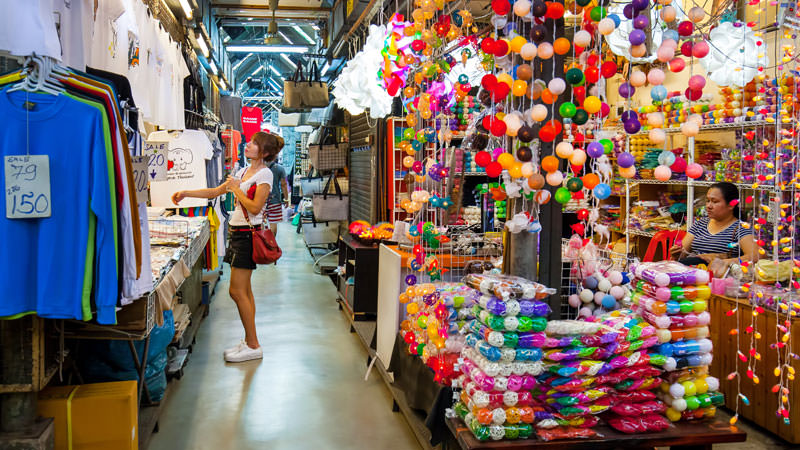The best way to explore Thailand’s vibrant capital, Bangkok, is through its bustling open-air markets.
One of the best aspects of a visit to the Thai capital has to be its abundance of colorful and often eclectic markets. Here, commerce continues as it has since the days of King Rama II, and a visit to the city’s many market places is a chance to delve into the Thai persona, its dynamic culture, and its culinary heritage.
When it comes to Bangkok markets, virtually everyone knows the Chatuchak Weekend Markets (above), Thailand’s largest and a treasure trove for shoppers and amateur photographers. Known simply as JJ after its Thai name Jatujak, Chatuchak covers an area of 27 acres – about the same as 30 soccer pitches – and is home to a whopping 15,000 stalls.
The Chatuchak Weekend Market is always busy, with approximately 200,000 visitors each weekend, including plenty of tourists. Split into a total of 27 sections, there is a little something for everyone, including household items, silks, plants and flowers, furniture, clothing, religious artifacts, collectibles, handicrafts, and art supplies. Weaving your way between the covered stalls you’ll find everything from framed pictures of the Thai king, to pet accessories, fat goldfish in tanks, fresh fruit stands playing retro 80s music, table lights made from Beer Chang bottles, Thai kickboxing shorts, jars of pandan paste, and tiny CD stores specializing in traditional folk music.

The beauty is you can barter down the price – a big drawcard for tourists looking to get as much bang for their baht as possible. In section 27 there are also open-air food stalls cooking up a storm so the best bet is to arrive early via tuk-tuk, the Kamphaengphet MRT station, or the Mo Chit BTS Skytrain, before the heat of the day turns the markets into a sauna, and have lunch when you’re shopped out.
Thai cuisine is well-known the world over, and its complex ingredients of spices, pastes, and herbs can all be found at the Khlong Toei Market, Bangkok’s largest fresh produce and spice market. Not for the faint-hearted, this sprawling market is where a lot of the city’s restaurant chefs come to buy ingredients, jostling for space with housewives and grannies in pajamas for the best chilies, the best heads of lettuces, and the best-barbequed baby chicks and steamed turtles.
In the spice aisles, you’ll find minority women in brightly colored traditional garb presiding over stalls packed with chilies – thick ones, thin ones, some harmless-looking, some positively lethal. With everything from cumin, coriander seed, turmeric, and fenugreek, a myriad colorful sacks of spices are heaped at each stall, blazing from bright yellow to terra-cotta red and grass green in the early morning sun. Here, amateur cooks can find all the ingredients so important to iconic dishes like tom yum soup, including lemongrass, kaffir lime leaves, galangal, fresh, plump limes, and tangy fish sauce.

A few years back now, floating markets in Bangkok were all the rage. But then, like so many great ideas, they became over touristy. Fortunately, the Taling Chan Floating Markets, which was started in 1987, has managed to retain much of its down-to-earth charm.
Only open on weekends between 8 am and 4 pm, it’s a visually stimulating spectacle; longboats from outlying villages, stacked with sacks of sugar cane, coconuts, and dragonfruit, pry their way between other boats stacked with buckets of fresh prawns and river fish, vying for business down the main Khlong Chak Phra canal.
In some sections, you’ll find floating street stalls, with women in straw hats balancing effortlessly as they prepare snacks for diners, both on the water and on the canal banks. There are also floating food barges where you sit on the floor at tiny tables. If you prefer to eat on terra firma there are shaded restaurants where you can be serenaded by live Thai folk music while you snack on kanom jeeb, steamed fish dumplings, and crispy strips of deep-fried tofu, washed down with local Beer Chang. When you’re done, return to the city on the number 79 or 83 boat.
For something a little more contemporary, you can’t go past the Talat Rot Fai Railways Markets, also known as the Railway Markets because it takes place on a piece of land owned by the railways. One of the city’s ‘newest’ markets and only open on weekends, this bazaar really only gets going after sundown.

Talat Rot Fai is best known for its vintage – sometimes kitsch – collectibles and yet is relatively tourist-free. Here you’ll find everything from old Vespa scooters in need of some TLC and dated pinball machines, to old cameras and battered cocktail shakers. You can pick up great deals on antique furniture if you’re planning on staying in Bangkok for a while, as well as plenty of other odds and ends, some genuine, some recreations.
There is a lack of pretension in the air; just people of today’s generation inquisitive about the past (or trying to recreate it), and the hipster vibe makes it a great spot for amateur photographers or visitors to the city looking for a cool outdoor setting.
Make time for a cocktail, served from one of the converted VW Combi van bars, or grab an ice-cold beer from one of the impromptu stands and drink it sitting in one of the abandoned carriages which line the venue. Get to the market through Kamphaengphet Station or by tuk-tuk, whose drivers seem more aware of the new markets than the cabbies.
For more unique Experiences click here.

